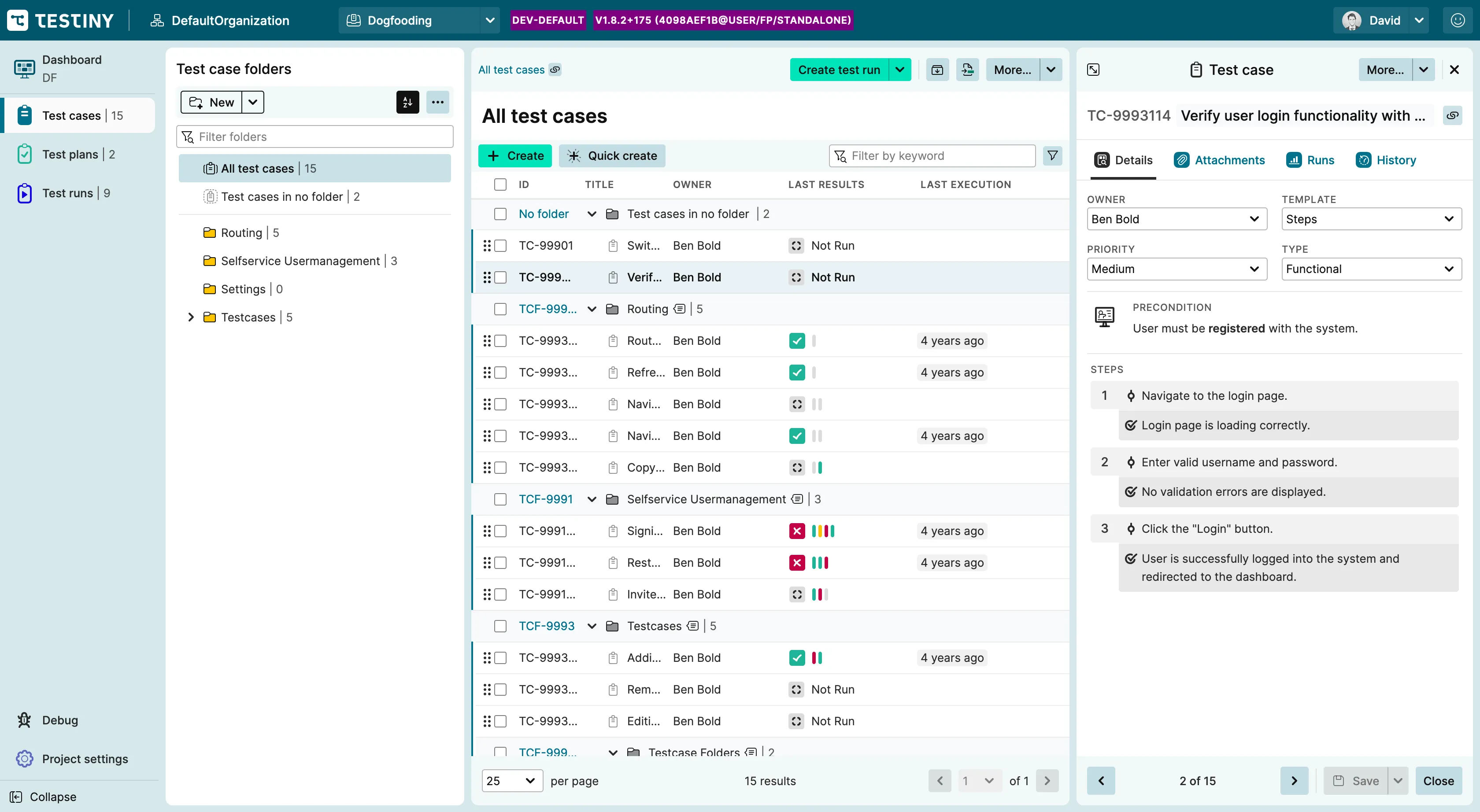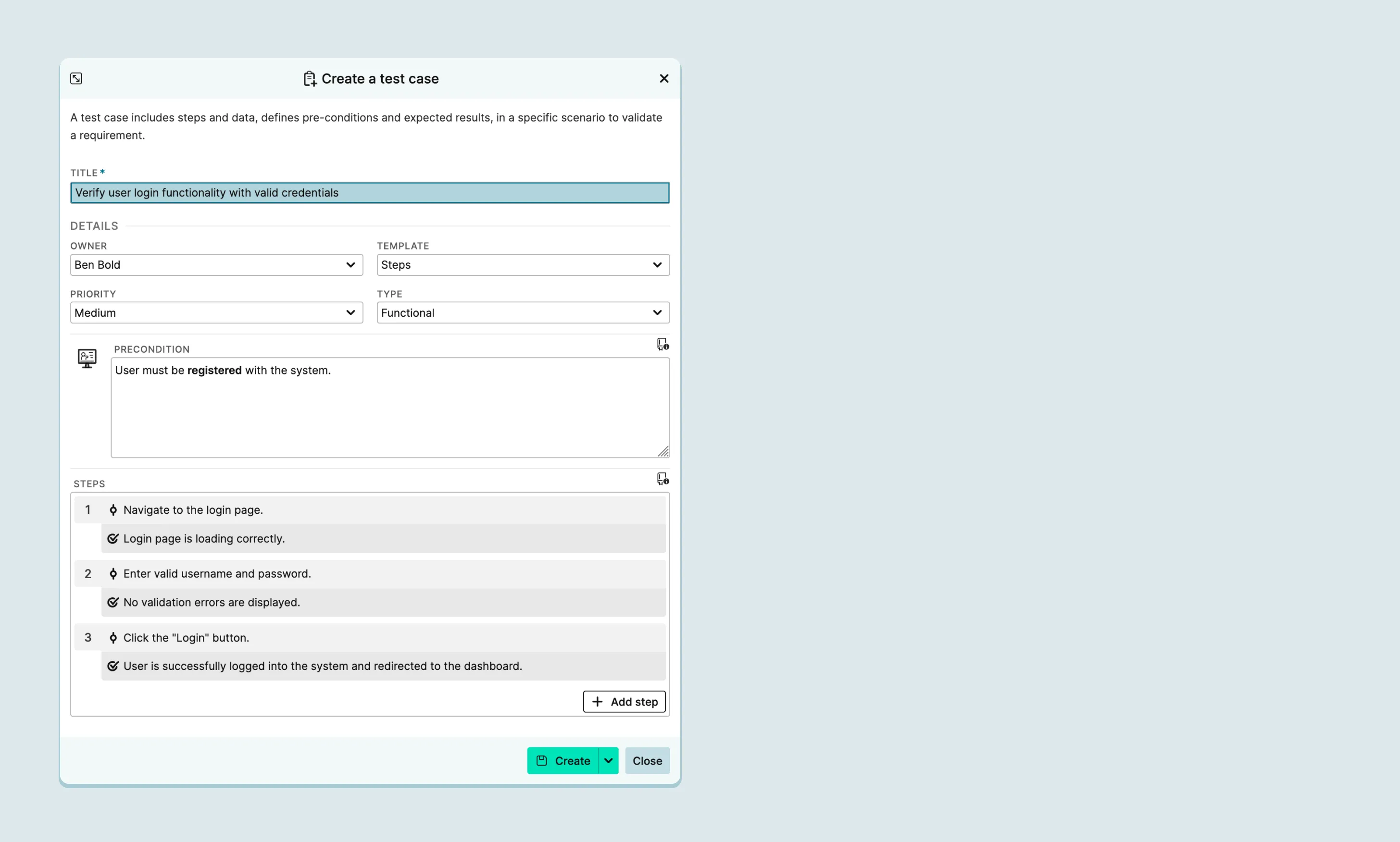How to write great test cases
Writing good test cases is essential for ensuring comprehensive test coverage, effective bug detection, and efficient software testing. With Testiny, we support your QA efforts in every step of your testing journey. Here are some key steps and best practices for writing high-quality test cases.

Understand requirements
• Analyze functional and non-functional requirements: Before writing a test case, ensure you understand
the user expectations, and performance requirements. This helps in identifying what needs to be tested and how to structure
the test case.
• Clarify ambiguities: If there’s any uncertainty, clarify it with the developer,
or product owner. Well-defined requirements lead to better test case quality. In Testiny, you can also link Requirements
from other services like Jira to your test cases, out of the box
we support over 15 integrations but you can add custom services too.
Keep test cases simple and clear
• Use clear and descriptive titles: Each test case should have a clear, concise title that describes
the test's purpose. It should indicate what functionality is being tested.
• Use simple, easy-to-understand language: Test cases should be written in plain language that is easily understood by anyone, regardless of technical expertise.
• Avoid ambiguity: Use precise terms and avoid vague language to ensure the tester knows exactly
what is expected.
Write test cases that are specific and test one thing
• Single focus per test: Each test case should verify one functionality or behavior. This makes it easier
to identify the root cause of a failure and reduces complexity.
• Break down complex tests:If a feature has multiple facets, create separate test cases for each one instead of combining them into a single
case.
Structure of a good test case
- Test case ID:
- A unique identifier for easy referencing (e.g., TC-01). Testiny creates an ID automatically.
- Test case title/name:
- Briefly describes what the test is validating.
- Preconditions:
- Any setup, environment conditions, or data needed before executing the test.
- Test steps:
- A step-by-step guide on how to execute the test. Each step should be simple and actionable. Use the steps template in Testiny to optimize the readability during test execution.
- Test data:
- Any input values or data required during the test. Did you know that Testiny supports copyable snippets to easily copy and paste credentials and other test data?
- Expected results:
- Clearly define the desired outcome for each step to verify if the test passes or fails.
- Post-conditions (Optional):
- Any cleanup or reset actions required after the test execution.

Further best-practice tips.
Include both positive and negative scenarios
• Positive test cases: These test the system’s behavior with valid inputs to ensure it functions as
expected (e.g., entering correct login details).
• Negative test cases: These test the system’s
response to invalid or unexpected inputs (e.g., entering an incorrect password or leaving fields blank). Negative testing
ensures the system is robust and can handle edge cases gracefully.
Ensure test case independence
• Avoid dependencies: Test cases should not depend on each other. Each test case should be executable
independently, meaning it shouldn’t require the execution of other test cases to succeed.
• Isolated data setup: Ensure that the preconditions and test data are unique for each test case. This prevents one test case from interfering
with others.
Be concise but detailed
• Conciseness: While it’s important to be thorough, avoid unnecessary details that may confuse or complicate
the test. Keep your test steps direct and to the point. Structure test cases with templates.
• Detail in expected results: Ensure expected results are well-defined. This helps testers
clearly differentiate between passing and failing conditions.
Make test cases reusable
• Modular design: Create test cases in a modular fashion so that they can be reused across different
projects or test runs.
• Avoid hard-coded values: Use variables or test data inputs that
can be modified easily for different scenarios rather than hard-coding specific values.
Prioritize test cases
• Critical vs. non-critical tests: Identify which test cases are crucial for the core functionalities
of the application and prioritize them accordingly. Critical test cases should be run frequently or early in the testing
process to catch high-impact issues sooner. Our test plan allows you to create test runs based on different criteria
with dynamic filters, so you can catch all test cases with a “Critical” status.
• Use risk-based testing: Focus on areas that have the highest risk of failure, such as newly developed features, complex integrations, or known
trouble spots.
Peer review and feedback
• Have others review your test cases: A second set of eyes can help catch gaps, unclear steps, or mistakes.
Peer reviews also ensure the test cases align with the project’s objectives and standards. Testiny’s permission system
and the modern architecture encourage and foster collaboration, you don’t have to worry about other people overwriting
your changes.
• Incorporate feedback: Be open to feedback and update your test cases as
needed to improve their quality and coverage.
Keep test cases up-to-date
• Update for changes in requirements: As the application evolves, ensure that your test cases are updated
to reflect new functionalities, changes, or bug fixes. We have added the functionality to add comments to your test cases
during execution to give feedback on the specific test case while you’re working on it.
• Remove obsolete test cases: Periodically review your test suite to identify and retire outdated or redundant test cases.
Automate when possible
• Identify candidates for automation: Not all test cases need to be automated, but frequently executed
test cases, regression tests, and those with repetitive steps are ideal candidates for automation. Use our CLI tool to
submit your automated test results to your Testiny instance.
• Maintain separate test cases for automation and manual testing: While automation is powerful, some scenarios (such as exploratory or UX/UI testing) are better suited for manual execution.
Summary of best practices
1. Understand requirements: Clear understanding of what needs to be tested.
2. Clear structure: Use a clear format with specific components.
3. Positive and negative tests: Include both success and failure scenarios.
4. Test independence: Make test cases independent and reusable.
5. Frequent reviews: Continuously review and update test cases based on feedback and changes.
By following these best practices, you can create well-organized, effective test cases that improve your
software's quality, simplify troubleshooting, and enhance collaboration within your team.

Level up your testing game.
Start using Testiny today.
Free 21-day trial available. No credit card required.